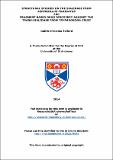Files in this item
Structural studies on the sialidase from Aspergillus fumigatus, and, Fragment based drug discovery against the trans-sialidase from Trypanosoma cruzi
Item metadata
| dc.contributor.advisor | Taylor, Garry L. | |
| dc.contributor.author | Telford, Judith Christina | |
| dc.coverage.spatial | xx, 241 p. | en_US |
| dc.date.accessioned | 2016-01-26T14:55:45Z | |
| dc.date.available | 2016-01-26T14:55:45Z | |
| dc.date.issued | 2014 | |
| dc.identifier | uk.bl.ethos.678192 | |
| dc.identifier.uri | https://hdl.handle.net/10023/8086 | |
| dc.description | Electronic version excludes material for which permission has not been granted by the rights holder | en_US |
| dc.description.abstract | Sialic acids are a family of 9 carbon acidic sugars that are often part of glycans that decorate glycoproteins and glycolipids. N-acetylneuraminic acid, or Neu5Ac, is the predominant sialic acid in Homo sapiens and is most commonly found on the terminus of glycan chains where it functions as a signalling molecule or providing a negatively-charged mask to cells. Neu5Ac is less commonly found in microbes. A number of pathogens, including the fungus Aspergillus fumigatus and the parasite Trypanosoma cruzi, present Neu5Ac on their surface which aids evasion of the host immune system. A. Fumigatus has no known sialic synthesis genes however a single sialidase, AfS, has been identified. This sialidase is relatively poor at cleaving Neu5Ac in comparison with other members of the sialidase family. Here we present the structure of AfS to 1.8Å, the first fungal sialidase structure published. The overall topology of AfS shares the 6-bladed β-propellor fold common to all known sialidases and has an rmsd of only 1.44 Å over 309 C[sub]αs with the bacterial sialidase from Micromonospora viridifaciens. The active site of AfS also contains all the residues necessary for efficient hydrolysis of sialic acids. Despite repeated attempts. It was not possible to crystallize AfS in complex with Neu5Ac. Closer inspection of the AfS active site revealed that the pocket that usually accommodates the N-acetyl moiety of Neu5Ac contained more polar residues and was shallower than that of other sialidases. The apo structure suggested that substitution of the N-acetyl group on C5 of Neu5Ac with a smaller group may be accommodated better in the active site of AfS. 2-Keto-3-deoxy-D-galactononulosonic acid (KDN), which has a hydroxyl group at this position, is capable of binding in the active site and is the preferred substrate of AfS. The structure of AfS in complex with KDN was determined to 1.45 Å and is the first KDN specific sialidase structure determined. Crystal complexes with either a di-fluoro-KDN or KDN2en allowed atomic snapshots to be obtained of the catalytic cycle from Michaelis complex, through transition state to covalent intermediate. Several KDN binding sites on the surface of the enzyme were discovered suggesting that the enzyme may be specific for polyKDN, which intruigingly has been found in the human lung. Mutations were made to AfS to enlarge the cavity around C5 to see if the enzyme could accommodate Neu5Ac-related substrates. Identification and mutation of arginine 171 in the active site to leucine increased the depth and hydrophobicity of the cavity and improved the ability of AfS to utilize Neu5Ac, albeit poorly. The structure AfS[sub](R171L) in complex with Neu5Ac2en was solved to 1.8 Å. Trypanosoma cruzi is the etiological agent of Chagas disease. The trans sialidase from T. cruzi, TcTs, is a verified virulence factor. Here we detail a fragment-based search for novel inhibitors of TcTs using a fluorogenic assay, STD-NMR and WaterLOGSY-NMR, in silico screening and X-ray crystallography. There was poor agreement between the techniques used and only fragment hits validated by X-ray crystallography were pursued. All protein-ligand complexes shared two common interactions. The verified compounds interacted with the arginine triad via a carboxylic acid, as is the case with the sialic acid substrate. Secondly, all compiunds possessed an amine that was within hydrogen bonding distance of the TcTs catalytic aspartic acid. One of these compunds, 3-piperidinic acid, was capable of binding in the TcTs active site in both of its anomeric forms. Interestingly, each anomer binds in 2 similar but distinct positions in the active site. In one of these conformations Tyr119 moves into the active site and hydrogen bonds with the fragment’s amine. In an attempt to combine the interaction seen in both the R and S anomers of 3-piperidinic acid, (R)-2-piperazine carboxylic acid was soaked into TcTs crystals. This compound made additional interactions with the protein and demonstrated a 4-fold improvement in the IC50. A known sialidase inhibitor, Siastatin B, based on a 3-piperidinic acid frame was also investigated and we present a TcTs-siastatin B complex structure to 2.1 Å, the first structure of Siastatin B in complex with a glycoside hydrolase. There is much work to be done to these preliminary inhibitors however here we have identified 3 druggable sites within the TcTs active site. The research presented herein provides a platform for future drug design studies on TcTs. | en_US |
| dc.language.iso | en | en_US |
| dc.publisher | University of St Andrews | |
| dc.subject.lcc | QP609.N48T4 | en_US |
| dc.subject.lcsh | Neuraminidase | en_US |
| dc.subject.lcsh | Aspergillus fumigatus | en_US |
| dc.subject.lcsh | Trypanosoma cruzi | en_US |
| dc.title | Structural studies on the sialidase from Aspergillus fumigatus, and, Fragment based drug discovery against the trans-sialidase from Trypanosoma cruzi | en_US |
| dc.type | Thesis | en_US |
| dc.type.qualificationlevel | Doctoral | en_US |
| dc.type.qualificationname | PhD Doctor of Philosophy | en_US |
| dc.publisher.institution | The University of St Andrews | en_US |
This item appears in the following Collection(s)
Items in the St Andrews Research Repository are protected by copyright, with all rights reserved, unless otherwise indicated.

